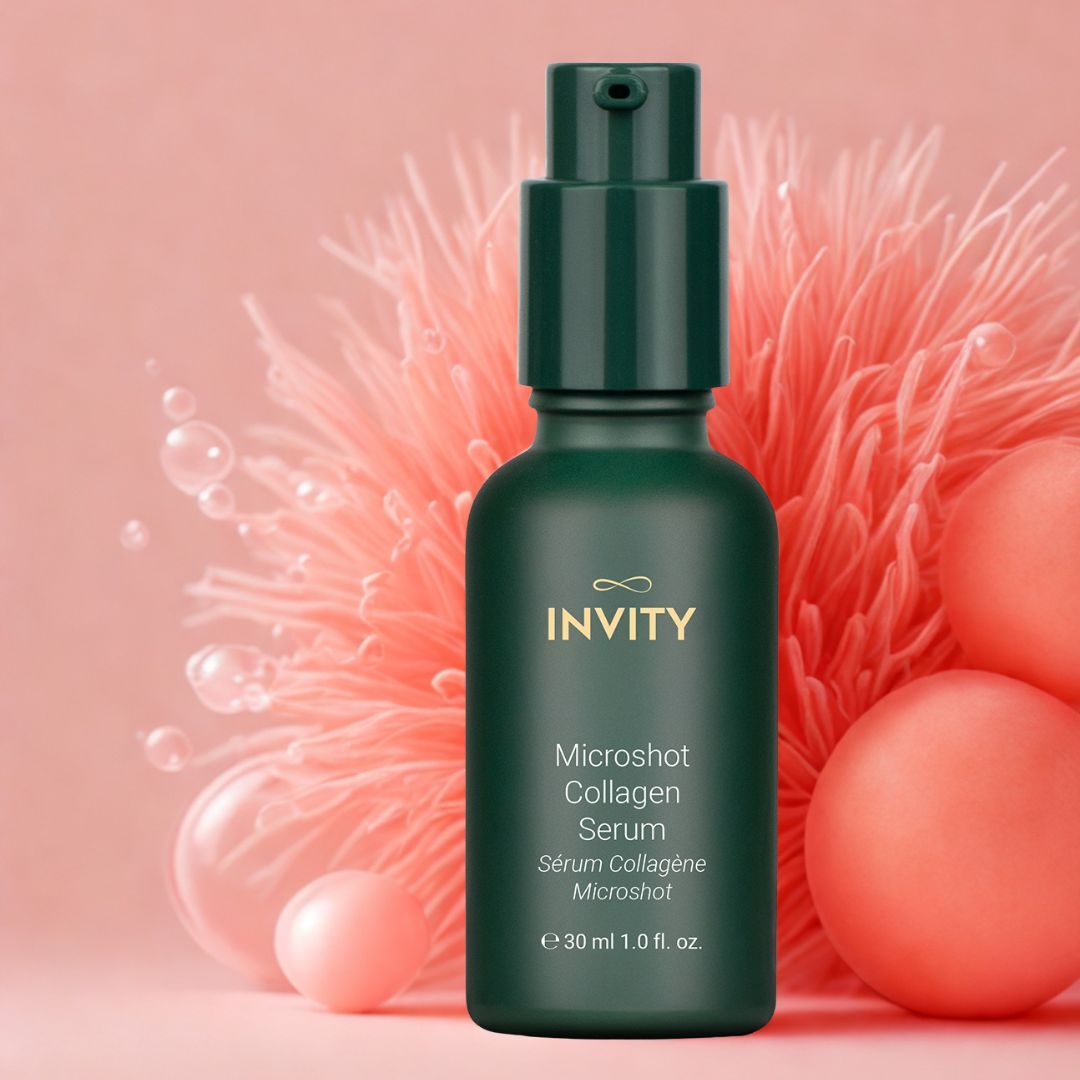Exosomes: Your Need-to-Know on the Next Skin Rejuvenation Frontier
15th Oct 2025

Part 4 of our “Collagen” Series
You’ve probably heard the buzz around exosomes, the at times controversial ingredient gaining attention as a possible game-changer in skincare. In this fourth chapter of our Collagen series, we’re layering on exosomes – what they are, why everyone’s talking about them, why plant-derived (Centella) exosomes are compelling, what the science currently supports (and doesn’t), and how they dovetail with a collagen‑banking mindset with Microshot Collagen Serum.
Part 1: Is Collagen Banking Really Possible? Science, Scepticism and Smart Skincare
Part 2: Microneedling Reinvented: From In‑Clinic Needles to “Microneedling in a Jar”
Part 3: Vegan vs Salmon PDRN: DNA Repair Signal For Calmer, Firmer, Glowier Skin
Part 4: You are here
What exactly are exosomes?
Exosomes are extracellular vesicles – microscopic lipid bubbles that cells release naturally to communicate with one another. Inside those bubbles you’ll typically find proteins, lipids, and nucleic acids.
Think of them like this: exosomes are shipping containers for signals. Helpful, yes, but delivery depends on the quality of the cargo, the route, and the “address”.
When exosomes interact with other cells (e.g., fibroblasts in the dermis), they can influence behaviour by passing on signal instructions.
Why aesthetics are paying attention
If you can deliver the right signals to the right cells at the right time, you might nudge the skin toward calming inflammation, better repair, and more robust collagen remodelling – especially after procedures that temporarily open micro‑channels (such as microneedling, fractional laser or radiofrequency).
They’re also controversial: sourcing, stability, and safety data vary widely.
Why the buzz – and the debate?
The promise
- Post‑procedure recovery: Some clinics pair exosome serums with microneedling to reduce visible downtime (redness, roughness) and support the remodelling phase.
- Texture + firmness: Early research and practice reports suggest potential improvements in fine lines, smoothness, elasticity and hydration – including with plant‑derived (e.g., Centella) exosome fractions.
- Inflammation modulation: Certain exosome preparations seem to carry anti‑inflammatory signals that may help a sensitised or post‑treatment barrier feel calmer, faster.
The cautions
- Sourcing questions: Exosomes can be human‑, animal‑, or plant‑derived. Human or animal sources raise ethical and regulatory concern. Plant‑derived exosomes ease those concerns but still need robust, product-specific clinical data.
- Evidence gaps: Much of the category still leans on in-vitro or small clinical series. Larger, longer, controlled human trials will clarify efficacy, penetration, durability, and safety.
- Formulation complexity: Exosomes are delicate. Stability, storage, and compatibility (temperature, preservatives, surfactants) all matter. A jar on a warm shelf may not protect vesicles the way a cold‑chain serum can.
Who should press pause (for now)
- Pregnant or breastfeeding (unless your clinician green-lights it)
- If you have an active infection, dermatitis flare, or compromised barrier
- Anyone uncomfortable with human- or animal-derived ingredients. Choose plant exosomes.
Our Take
At Invity, we recognise that the field is young and regulations differ by source and by their route (topical vs injectable). We focus on plant‑derived (Centella) extracellular vesicles in topical formats (i.e., a skin serum), which have promising research for tolerability and potential skin‑quality benefits, as well as offering ethical and regulatory comfort.
If you’re curious, approach exosomes thoughtfully: pick reputable providers, ask hard questions, and anchor your routine in proven strategies, like collagen banking and smart topicals such as Microshot Collagen Serum (with Centella‑derived plant exosomes) to support your skin’s repair environment before and after pro treatments.
Exosomes through the collagen‑banking lens
Collagen banking is about compounding advantages: protect what you have, stimulate thoughtfully, and support repair so that the gains “stick”. So where do exosomes logically fit in?
Before procedures (pre‑conditioning): A calm, well‑nourished barrier typically responds better and recovers faster. Ingredients that optimise the repair environment – hydrators, barrier lipids, antioxidants, and peptides set the stage for exosome signals to be received effectively.
Immediately post-procedure: When microneedling creates micro‑channels, timing matters. Some clinics apply exosome solutions during the enhanced-penetration window. (Always follow your practitioner’s protocol.)
Remodelling phase (days to weeks): Consistency wins. Supporting fibroblasts with pro‑collagen actives and sufficient hydration can help the micro‑injury-to-remodelling cycle translate into visible texture and firmness.
Where Microshot Collagen Serum comes in

Microshot Collagen Serum is designed for the long skin game – banking collagen and maximising the reward‑to‑downtime ratio of professional treatments. It combines:
- Biomimetic collagen peptides
- Plant-based (vegan) PDRN
- NMN
- Spicule microneedle delivery
- Centella-derived exosomes
Rather than treating exosomes on top, Microshot Collagen Serum integrates a Centella Asiatica exosome fraction that works alongside peptides and NMN to nudge fibroblasts, help neutralise oxidative stress, and support orderly skin remodelling.
How this helps:
- Signal synergy: Centella‑derived exosomes can complement collagen‑signalling peptides, helping the skin “hear” regeneration cues while peptides provide redundant pathways.
- Delivery support: Microshot Collagen Serum’s spicule microneedle system creates micro-channels that can aid penetration of delicate vesicles.
- Comfort: The hydrating base cushions post-treatment skin.
- Ethical + regulatory comfort: Plant‑origin exosomes avoid human‑derived sourcing concerns and may align more clearly with cosmetic regulations in many regions.
How to use Microshot Collagen Serum
- Pre‑treatment: Apply the serum once or twice daily for 1–2 weeks before clinical microneedling to optimise hydration and barrier resilience.
- Post‑treatment: Resume when your provider gives the all‑clear (usually 24–48 hours post‑procedure). The serum’s soothing glide can be welcome while skin feels tight or flaky.
- Every-day maintenance: Keep Microshot Collagen Serum in your routine between treatments to support ongoing collagen banking.
The Invity take
Exosomes are one of the most talked‑about – and debated – frontiers in skin rejuvenation. There’s real scientific rationale for their potential but the research is still in its infancy. That’s why our guidance right now is pragmatic:
- Stay curious but cautious. Ask for sourcing and stability details, and human clinical data.
- Use exosomes as an addition, not a cornerstone. Your cornerstone is still a high‑compliance routine that protects and rebuilds collagen over years.
Leverage Microshot Collagen Serum to keep your skin in a receptive, resilient state before and after pro treatments, and as your go-to collagen maintenance programme.
Read next
← Part 1: Is Collagen Banking Really Possible? Science, Scepticism and Smart Skincare
← Part 2: Microneedling Reinvented: From In‑Clinic Needles to “Microneedling in a Jar”
← Part 3: Vegan vs Salmon PDRN: DNA Repair Signal For Calmer, Firmer, Glowier Skin
FAQs
Do exosomes replace retinoids, peptides or growth-factor-style serums?
No. Exosomes are a category, not a replacement. Keep the proven pillars: UV discipline, retinoids (if tolerated), hydration and barrier support. Microshot Collagen Serum becomes a daily pillar.
Are plant-derived exosomes the safer middle ground?
They often feel better ethically and can fit more comfortably within cosmetic frameworks. Equivalence to human-derived exosomes isn’t established – evaluate products on their own data.
Can I DIY exosomes after dermarolling at home?
We don’t recommend this if using human- or animal-derived exosomes, as this could add infection risk and depth variability. In this instance, do it in-clinic with sterile protocols. For home use, use a plant-derived exosome serum (like Microshot Collagen Serum) after dermarolling.
What results should I expect from professional exosome therapy?
Set expectations conservatively. Some see faster recovery and a smoother look post-clinical procedure; others notice little difference. Baseline routine, consistency, and practitioner technique matter.
